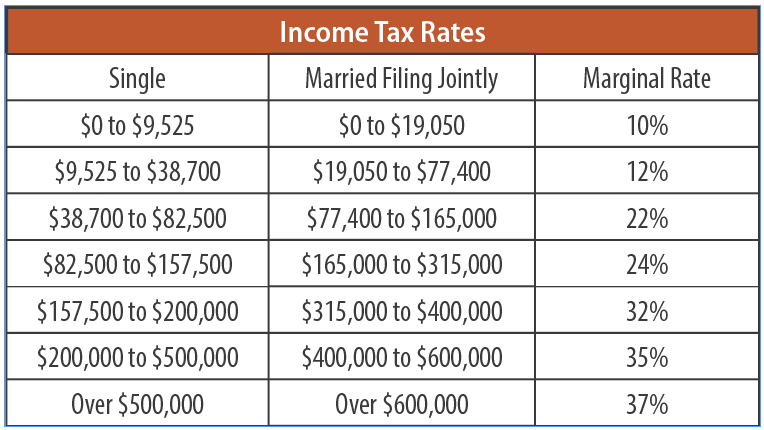Download the Printable Version Here
December 22, 2017
It’s been over 30 years since Congress passed a significant tax bill. While many taxpayers will pay lower taxes due to the Tax Cuts and Jobs Act, not everyone will benefit and, in fact, some will pay more tax. Regardless of whether a particular taxpayer “wins” or “loses”, most of the provisions that apply to individuals will expire in eight years, so any changes will be relatively short-lived.
A few highlights of the new legislation that President Trump signed into law on December 21, 2017 include lower marginal tax rates for corporations and individuals, an increase of the estate tax exemption, changes to itemized deductions, adjustments to the Alternative Minimum Tax (AMT), and a new 20% deduction for qualifying pass-through entities and sole proprietors. A more complete list of changes begins on page 2.
The majority of the tax legislation will become effective January 1, 2018, which leaves a few days remaining in 2017 to implement year-end planning ideas. In light of the new legislation, we have identified four planning items to consider prior to December 31st.
Year-End Planning
- Pay unreimbursed employee expenses and other miscellaneous itemized deductions – Unreimbursed employee expenses, such as tools, supplies, union dues, travel, and training; along with tax preparation fees and investment expenses are able to be deducted in 2017 to the extent they exceeded 2% of a taxpayer’s Adjusted Gross Income (AGI). The new tax legislation eliminates the miscellaneous itemized deduction beginning in 2018. Be sure to pay outstanding invoices for these items and, if possible, pre-pay 2018 expenditures in 2017 to maximize the benefit from the deduction.
- Pay real estate tax, sales tax, and state/local income tax – Beginning in 2018, taxpayers will be limited to $10,000 for the combined state income tax, sales tax, and real estate tax deduction. For 2017, these deductions are not limited, though the Alternative Minimum Tax (AMT) may reduce the net tax benefit. Consequently, taxpayers will want to ensure that all 2017 state income taxes and real estate taxes are paid prior to December 31. It might also be beneficial to pre-pay real estate tax and sales tax, if possible (Washington State does not allow taxpayers to pre-pay real estate tax).
- Defer income – Even in years without major tax legislation, if possible, it usually makes sense to delay recognizing income until a later tax year. For 2017 year-end, this strategy is even more important as income will likely be taxed at a lower effective rate in 2018.
- Give to charity – The new tax legislation increases the standard deduction from $12,700 to $24,000 for married taxpayers filing jointly. With the increased standard deduction, relatively low limit on taxes, and the elimination of miscellaneous itemized deductions, it will be more difficult to itemize deductions going forward. The tax legislation also reduces marginal tax rates so future deductions will generate a lower tax benefit. Consequently, large charitable contributions might be most beneficial if paid in 2017 compared to future years.
Overview of Tax Cuts & Jobs Act
Please note that most changes are effective for tax years beginning after December 31, 2017. Furthermore, most changes for individuals expire December 31, 2025, whereas most changes for businesses are permanent.
Individuals
- Decreased income tax rates and brackets – Under the new law, tax rates are reduced with the highest tax rate now 37% for taxable income over $600,000 for married filing joint taxpayers, and $500,000 for single taxpayers. See the table below for details of rates and brackets.

- Increased standard deduction – The standard deduction is increased to $24,000 for married individuals filing a joint return and $12,000 for single individuals. The additional standard deduction for the elderly and blind remains unchanged.
- Personal exemptions are eliminated.
- Kiddie tax modified – Taxable income of a child attributable to earned income is now taxed under the rates for single individuals, and taxable income attributable to net unearned income (interest, dividends, capital gains, etc.) is taxed according to the rates for trusts.
- Personal casualty and theft loss deduction suspended – The casualty loss is eliminated except for personal casualty losses incurred in a Federally-declared disaster.
- Child tax credit increased – The child tax credit is increased to $2,000 and the phase-outs are increased to $400,000 for married filing jointly and $200,000 for all other taxpayers. In addition, a $500 nonrefundable credit is provided for certain non-child dependents.
- State and local tax deduction limited – Taxpayers may claim an itemized deduction of up to $10,000 for the aggregate of property tax, sales tax, and/or state income tax.
- Mortgage and home equity indebtedness interest deduction limited – The deduction for interest on home equity indebtedness is suspended, and the deduction for mortgage interest is limited to underlying indebtedness of up to $750,000. The new lower limit does not apply to indebtedness acquired before December 15, 2017.
- Medical expense deduction threshold temporarily reduced – For 2018 only the threshold on medical expense deduction is reduced to 7.5% of adjusted gross income.
- No deduction for college athletic seating rights – No charitable deduction is allowed for any payment to a higher educational institution for which the payor receives the right to purchase tickets or seating at an athletic event.
- Alimony deduction by payor and inclusion by payee suspended – For any divorce or separation agreement executed after December 31, 2018, alimony and separate maintenance payments are not deductible by the payor spouse and are not included in income of the payee spouse.
- Miscellaneous itemized deductions suspended – The deduction for miscellaneous itemized deductions that are subject to the 2% floor is suspended. Miscellaneous itemized deductions include unreimbursed employee expenses, tax preparation fees, and investment advisor fees.
- Overall limitation (Pease Limitation) on itemized deductions is suspended.
-
Moving expense deduction is suspended.
-
Repeal of Obamacare individual mandate – The Affordable Care Act (ACA or Obamacare) penalty for not having health insurance coverage is permanently repealed beginning in 2019. The 3.8% net investment income tax and the 0.9% additional Medicare tax are still intact.
-
Alternative Minimum Tax (AMT) is retained with higher exemption amounts.
-
Expanded use of 529 account funds – The definition of qualified higher education expenses for tax-free distributions from 529 accounts now include tuition at an elementary or secondary public, private, or religious schools.
-
Estate and gift tax retained, with increased exemption amount – The lifetime exemption for estate and gift tax is increased to $11.2 million per person.
Businesses
- Corporate tax rates reduced – The corporate tax rate is reduced to a flat 21% rate.
- Corporate Alternative Minimum Tax (AMT) is repealed.
- New deduction for pass-through and proprietorship income – Non-corporate taxpayers with qualified business income (QBI) from a partnership, S corporation, or sole proprietorship are allowed a 20% deduction reducing taxable income. The deduction does not apply to certain service businesses, including health, law, accounting, consulting, and financial services (excluding investment-type activities).
- Increased Section 179 – For property placed in service beginning in 2018, the maximum Section 179 expense is increased to $1 million and the phase-out threshold is increased to $2.5 million. The definition of qualified real property eligible for Section 179 expensing is expanded to include roofs, HVAC, fire protection systems, and security systems.
- Temporary 100% cost recovery of qualifying business assets (bonus depreciation) – A 100% first-year deduction for qualified property (bonus depreciation) placed in service after September 27, 2017 and before January 1, 2023.
- Luxury automobile depreciation limits are increased.
- Employer’s deduction for fringe benefit expenses limited – Deduction for entertainment expenses are disallowed (50% deduction limit for meals is still allowed), and deductions for employee transportation fringe benefits (e.g. parking and mass transit) are eliminated, with benefits now considered taxable income to the employee.
- Recovery period for real property shortened – The separate definitions for qualified leasehold improvement, qualified restaurant, and qualified retail improvement property are now considered qualified improvement property with a 15-year recovery period.
- Limits on deduction of business interest – Business entities are generally subject to a limit on the deduction for interest expense in excess of 30% of the business’s adjusted taxable income. Excess business interest may be carried forward indefinitely.
- Domestic production activities deduction is repealed.
- New credit for employer-paid family and medical leave – For wages paid in tax years 2018 and 2019, businesses can claim a general business credit equal to 12.5% of wages paid to qualifying employees while such employees are on family and medical leave (FMLA) if the rate of payment is 50% of wages normally paid.
- Cash method of accounting – The cash method may be used by taxpayers that satisfy a $25 million gross receipts test.
- Accounting for inventories – Taxpayers that meet the new limit for cash method of accounting are not required to account for inventories using accrual method of accounting.
- Capitalization and inclusion of certain expenses in inventory costs – Any producer or re-seller that meets the new limits for cash method of accounting is exempt from application of the uniform capitalization (UNICAP) rules.
Regardless of your political preferences, there is benefit to being aware of the tax planning opportunities available to you for 2017 and beyond. Decisions you make this year could have a direct impact on your long term financial security, so it pays to plan and take action now to ensure your goals can be achieved.
Contact Jenny Keeney or Ryan Blume for more information.
(425) 404-3540

Jenny Keeney, CPA, MPAcc
Partner
(425) 404-3544
jenny@blumekeeney.wpmudev.host

Ryan Blume, CPA, CFP®
Partner
(425) 404-3545
ryan@blumekeeney.wpmudev.host
Any tax advice contained in this communication, unless expressly stated otherwise, was not intended or written to be used, and cannot be used, for the purpose of (i) avoiding tax-related penalties that may be imposed on the taxpayer under the Internal Revenue Code or applicable state or local tax law or (ii) promoting, marketing, or recommending to another party any tax-related matters addressed herein.

